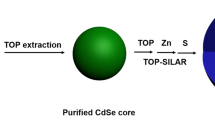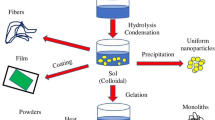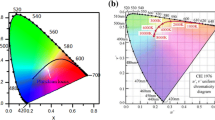Abstract
The production of high-quality eco-friendly quantum dots (QDs) is challenging because of the efficient yet elusive nonradiative recombination within. This study examined the effects of cooling engineering on regulating the excited states to realize high-quality ZnSeTe core-shell QDs. The presence of ultrafast hot-carrier trapping and band-edge carrier trapping is responsible for the poor emission efficiency in ZnSeTe QDs. The above processes can be suppressed simultaneously by engineering the cooling process, and the underlying mechanisms are interrogated by combined electronic and spectroscopic characterization. The engineered ZnSeTe QDs exhibited record-high efficiency (>90%) and stability that were comparable to those of the canonical CdSe QDs. Leveraging on the achievement, the ZnSeTe QD-based white light-emitting diodes (WLEDs) showed excellent optical performance, including a high color-rendering index of 80 and an appropriate correlated color temperature of 7391 K. Furthermore, the WLEDs could serve as light sources in eco-friendly visible light communication. These results highlight the feasibility of eco-friendly QDs for practical applications without environmental hazards.

摘要
由于材料内部存在高效的非辐射复合, 这使得实现高质量的环保量子点仍然具有挑战性. 本文中, 我们探索了通过冷却工程调节激发态对实现高质量的ZnSeTe核壳量子点的影响. 研究发现, 超快热载流子俘获和带边载流子俘获是ZnSeTe量子点发射效率低下的主要原因. 我们通过设计冷却工程抑制上述过程, 并且结合电子和光谱表征分析了其潜在机制. 经过冷却优化的ZnSeTe量子点表现出高量子发光效率(>90%)和稳定性, 这可与经典的CdSe量子点相媲美. 基于这种量子点的白光发光二极管(WLED)表现出优异的光学性能, 包括高显色指数(80)和良好的相关色温(7391 K). 此外, 高性能的WLED还可以用作环保可见光通信. 这些结果表明了环保量子点在实际应用中的可行性.
Similar content being viewed by others
References
Shirasaki Y, Supran GJ, Bawendi MG, et al. Emergence of colloidal quantum-dot light-emitting technologies. Nat Photon, 2012, 7: 13–23
Yoon SY, Kim JH, Kim KH, et al. High-efficiency blue and white electroluminescent devices based on non-Cd I–III–VI quantum dots. Nano Energy, 2019, 63: 103869
Won YH, Cho O, Kim T, et al. Highly efficient and stable InP/ZnSe/ZnS quantum dot light-emitting diodes. Nature, 2019, 575: 634–638
Dai X, Zhang Z, Jin Y, et al. Solution-processed, high-performance light-emitting diodes based on quantum dots. Nature, 2014, 515: 96–99
Wang A, Shen H, Zang S, et al. Bright, efficient, and color-stable violet ZnSe-based quantum dot light-emitting diodes. Nanoscale, 2015, 7: 2951–2959
Luo Z, Chen Y, Wu ST. Wide color gamut LCD with a quantum dot backlight. Opt Express, 2013, 21: 26269–26284
Padilha LA, Nootz G, Olszak PD, et al. Optimization of band structure and quantum-size-effect tuning for two-photon absorption enhancement in quantum dots. Nano Lett, 2011, 11: 1227–1231
Regulacio MD, Han MY. Composition-tunable alloyed semiconductor nanocrystals. Acc Chem Res, 2010, 43: 621–630
Zhang C, Chen J, Kong L, et al. Core/shell metal halide perovskite nanocrystals for optoelectronic applications. Adv Funct Mater, 2021, 31: 2100438
Qu L, Peng ZA, Peng X. Alternative routes toward high quality CdSe nanocrystals. Nano Lett, 2001, 1: 333–337
Lu M, Zhang Y, Wang S, et al. Metal halide perovskite light-emitting devices: Promising technology for next-generation displays. Adv Funct Mater, 2019, 29: 1902008
Lin K, Xing J, Quan LN, et al. Perovskite light-emitting diodes with external quantum efficiency exceeding 20 percent. Nature, 2018, 562: 245–248
Xie R, Battaglia D, Peng X. Colloidal InP nanocrystals as efficient emitters covering blue to near-infrared. J Am Chem Soc, 2007, 129: 15432–15433
Li L, Reiss P. One-pot synthesis of highly luminescent InP/ZnS nanocrystals without precursor injection. J Am Chem Soc, 2008, 130: 11588–11589
Gu YP, Cui R, Zhang ZL, et al. Ultrasmall near-infrared Ag2Se quantum dots with tunable fluorescence for in vivo imaging. J Am Chem Soc, 2012, 134: 79–82
Langevin MA, Ritcey AM, Allen CN. Air-stable near-infrared AgInSe2 nanocrystals. ACS Nano, 2014, 8: 3476–3482
Zhang W, Ding S, Zhuang W, et al. InP/ZnS/ZnS core/shell blue quantum dots for efficient light-emitting diodes. Adv Funct Mater, 2020, 30: 2005303
Asano H, Arai K, Kita M, et al. Synthesis of colloidal Zn(Te,Se) alloy quantum dots. Mater Res Express, 2017, 4: 106501
Li C, Nishikawa K, Ando M, et al. Synthesis of Cd-free water-soluble ZnSe1−xTex nanocrystals with high luminescence in the blue region. J Colloid Interface Sci, 2008, 321: 468–476
Jang EP, Han CY, Lim SW, et al. Synthesis of alloyed ZnSeTe quantum dots as bright, color-pure blue emitters. ACS Appl Mater Interfaces, 2019, 11: 46062–46069
Han CY, Lee SH, Song SW, et al. More than 9% efficient ZnSeTe quantum dot-based blue electroluminescent devices. ACS Energy Lett, 2020, 5: 1568–1576
Lee SH, Han CY, Song SW, et al. ZnSeTe quantum dots as an alternative to InP and their high-efficiency electroluminescence. Chem Mater, 2020, 32: 5768–5775
Peng ZA, Peng X. Formation of high-quality CdTe, CdSe, and CdS nanocrystals using CdO as precursor. J Am Chem Soc, 2001, 123: 183–184
Peng X, Manna L, Yang W, et al. Shape control of CdSe nanocrystals. Nature, 2000, 404: 59–61
Reiss P, Carrière M, Lincheneau C, et al. Synthesis of semiconductor nanocrystals, focusing on nontoxic and earth-abundant materials. Chem Rev, 2016, 116: 10731–10819
Abe S, Čapek RK, De Geyter B, et al. Tuning the postfocused size of colloidal nanocrystals by the reaction rate: From theory to application. ACS Nano, 2012, 6: 42–53
Sugimoto T. Preparation of monodispersed colloidal particles. Adv Colloid Interface Sci, 1987, 28: 65–108
Luo C, Yan C, Li W, et al. Ultrafast thermodynamic control for stable and efficient mixed halide perovskite nanocrystals. Adv Funct Mater, 2020, 30: 2000026
Dabbousi BO, Rodriguez-Viejo J, Mikulec FV, et al. (CdSe)ZnS core—shell quantum dots: Synthesis and characterization of a size series of highly luminescent nanocrystallites. J Phys Chem B, 1997, 101: 9463–9475
Peng X, Wickham J, Alivisatos AP. Kinetics of II-VI and III-V colloidal semiconductor nanocrystal growth: “Focusing” of size distributions. J Am Chem Soc, 1998, 120: 5343–5344
Wei K, Zheng X, Cheng X, et al. Observation of ultrafast exciton-exciton annihilation in CsPbBr3 quantum dots. Adv Opt Mater, 2016, 4: 1993–1997
Ren Y, Nie Z, Deng F, et al. Deciphering the excited-state dynamics and multicarrier interactions in perovskite core-shell type hetero-nanocrystals. Nanoscale, 2021, 13: 292–299
Kambhampati P. Hot exciton relaxation dynamics in semiconductor quantum dots: Radiationless transitions on the nanoscale. J Phys Chem C, 2011, 115: 22089–22109
Felici M, Polimeni A, Miriametro A, et al. Free carrier and/or exciton trapping by nitrogen pairs in dilute GaP1−xNx. Phys Rev B, 2005, 71: 045209
Yin Y, Alivisatos AP. Colloidal nanocrystal synthesis and the organic—inorganic interface. Nature, 2005, 437: 664–670
Fu Y, Kim D, Jiang W, et al. Excellent stability of thicker shell CdSe@ZnS/ZnS quantum dots. RSC Adv, 2017, 7: 40866–40872
Pal BN, Ghosh Y, Brovelli S, et al. ‘Giant’ CdSe/CdS core/shell nanocrystal quantum dots as efficient electroluminescent materials: Strong influence of shell thickness on light-emitting diode performance. Nano Lett, 2012, 12: 331–336
Song KK, Lee S. Highly luminescent (ZnSe)ZnS core-shell quantum dots for blue to UV emission: synthesis and characterization. Curr Appl Phys, 2001, 1: 169–173
Lin GR, Lo TC, Tsai LH, et al. Finite silicon atom diffusion induced size limitation on self-assembled silicon quantum dots in silicon-rich silicon carbide. J Electrochem Soc, 2011, 159: K35–K41
Nan W, Niu Y, Qin H, et al. Crystal structure control of zinc-blende CdSe/CdS core/shell nanocrystals: Synthesis and structure-dependent optical properties. J Am Chem Soc, 2012, 134: 19685–19693
Wang Y, Ta VD, Gao Y, et al. Stimulated emission and lasing from CdSe/CdS/ZnS core-multi-shell quantum dots by simultaneous three-photon absorption. Adv Mater, 2014, 26: 2954–2961
Acknowledgements
This work was supported by the National Natural Science Foundation of China (11904172) and Natural Science Foundation of Jiangsu Province (BK20190446). Wang Y thanks the support of the start-up funding from Nanjing University of Science and Technology.
Author information
Authors and Affiliations
Contributions
Author contributions Wang Y conceived the idea; Wu B prepared the materials; Wu B, Zhang M, and Huang Z conducted the characterization of materials. All the authors commented on the manuscript.
Corresponding author
Ethics declarations
Conflict of interest The authors declare that they have no conflict of interest.
Additional information
Supplementary information Supporting data are available in the online version of the paper.
Baoqiang Wu received his B.S. degree from Wuhan University of Science and Technology in 2019. He is now studying for a master’s degree in the School of Materials Science and Engineering at Nanjing University of Science and technology. His main research is the preparation and application of cadmium-free semiconductor nanocrystals.
Shuangyi Zhao received his B.S. degree from Shandong University in 2013 and Ph.D. degree from the State Key Lab of Silicon Materials at Zhejiang University in 2018. He is now a postdoctoral researcher in the College of Optoelectronic Engineering at Chongqing University. His research concerns the fabrication of semiconductor nanocrystals, including lead-halide and lead-free perovskites, and their applications in optoelectronic devices.
Mingshui Zhang received his B.S. degree at Nanjing University of Science and Technology in 2020. He is now studying for a master’s degree in the School of Materials Science and Engineering at Nanjing University of Science and Technology. His main research is the preparation and application of perovskite core-shell nanocrystals.
Yue Wang received his Ph.D. degree in physics from Nanyang Technological University. He is currently working at the School of Materials Science and Engineering, Nanjing University of Science and Technology. His research interests include optical spectroscopy, semiconductor photophysics, and optically pumped lasers.
Rights and permissions
About this article
Cite this article
Wu, B., Zhao, S., Zhang, M. et al. Excited-state regulation in eco-friendly ZnSeTe-based quantum dots by cooling engineering. Sci. China Mater. 65, 1569–1576 (2022). https://doi.org/10.1007/s40843-021-1957-9
Received:
Accepted:
Published:
Issue Date:
DOI: https://doi.org/10.1007/s40843-021-1957-9




